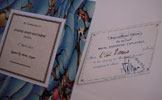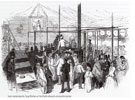An invitation card to the Dublin Soup Kitchen, signed by Soyer.
The cardboard invitation measures approx. 2"x3" It states: Soyer's Model Kitchen. For the Poor. Royal Barracks Esplanade. Admit (in manuscript [??] Jones) & Family. to the opening on Monday 5th April 1847. at half past 2 oClock. Within a simple decorated line border. Soyer's signature in blue ink at the bottom right hand corner.
Also enclosed are a two interesting articles copied from Irish newspapers, reporting on Soyers soup kitchens. Housed in a neat cardboard, marbled folder with a label on the front cover. An extremely rare item of Soyer ephemera.
- George Augustus Sala, on meeting Soyer in the Hungerford Market recalls, -- He wore a kind of paletôt of light camlet cloth, with voluminous lapels and deep cuffs of lavender watered silk; very baggy trousers, with lavender stripes down the seams; very shiny boots and quite as glossy a hat; his attire being completed by tightly-fitting gloves, of the hue known in Paris as 'beurre frais' — that is to say, light yellow. All this you may think was odd enough; but an extraordinary oddity was added to his appearance by the circumstance that every article of his attire, save, I suppose, his gloves and boots, was cut on what dressmakers call a "bias," or as he himself, when I came to know him well, used to designate as "à la zoug-zoug". He must have been the terror of his tailor, his hatter, and his maker of cravats and under-linen; since he had, to all appearance, an unconquerable aversion from any garment which, when displayed on the human figure, exhibited either horizontal or perpendicular lines. His very visiting-cards, his cigar-case, and the handle of his cane took slightly oblique inclinations. This explains precisely why this invitation card on offer here is such an odd shape; it is "à la zoug-zoug". After the Soup Kitchen Act was introduced on January 25th 1847, Soyer was invited by the Government and funded by private subscriptions, to go to Ireland during the winter of 1847 while the Great Famine was raging. The Soup Kitchen was set up on the banks of the Liffey in front of the Royal Barracks, Dublin. The wooden dining room was forty foot long by thirty feet wide. Soyer's soup was cooked and served from a 300 gallon boiler that looked like a traditional steam engine. It also had an oven at the end to bake one hundred-weight of bread at a time. The soup bowls were stuck to the table and the spoons were chained to the bowls. One hundred ate their soup with relish (according to the newspapers) then left when a bell rang, followed by another hundred who came in for their soup and piece of bread. The food was also conveyed by vehicles to distant outlying areas, for infants, the sick and the aged. Newspapers report that on the day of opening the Kitchens to the poor, the Lord Lieutenant of Ireland and other notables were invited to view the Kitchens and Dining room. This invitation card is for one of those guests on that occasion. This Gala opening also caused some outrage in some newspapers, due to the undignified way the poor had to eat the soup in front of the privileged Guests. Never the less Soyer's kitchen was successful and his services were retained by the Relief Commissioners. In the midst of much publicity, Soyer opened a number of 'model' Kitchens in Dublin. Under the Act, soup kitchens were to be established in each of the electoral divisions. By July 1847, 1,850 Soup kitchens were in operation feeding over 3 million people throughout Ireland. Soyer, long gone by this time, received a beautiful snuff box amid great fanfare before his departure.



click on image to enlarge

Ephemera category
ref number:
10991